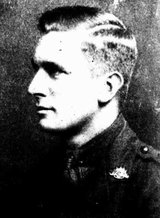On 20 January 1918 Captain Charles Aubrey Jhonson was awarded the Military Cross:
For conspicuous gallantry and devotion to duty. Though wounded early in the attack he continued to lead his company, and himself conducted the assault on the objective, and consolidated and secured the position. His courage and example contributed largely to the success of the operations.
Charles’ medal was one of 2,366 Military Crosses awarded to Australians during the First World War. Charles received his for bravery during the Battle of Polygon Wood in September 1917.
In November 1917 Charles received the following congratulatory letter from General Sir William Birdwood:
Dear Jhonson,
This is a line to congratulate you most heartily upon the Military Cross, which has been awarded to you for your good work in the operations at Polygon Wood on the 20th September. Although wounded early in the attack, you continued to lead your company with great courage and ability. Immediately the objective was attained, you set to work in the consolidation of the position, and refused to leave the line until the position was made secure— some nine hours after you were wounded.
Thank you so much for your gallant conduct, and I trust that your wound is making favourable progress.
Yours sincerely,
WB BIRDWOOD.
Charles was born in Bathurst on 5 January 1885 to solicitor Walter Jhonson and his wife Margaret Susannah nee Cleland. When Charles was a young boy the family moved to Orange where Walter practised as a solicitor.
Charles, aka Chas, was educated at Sydney High School. Prior to his war service he worked at the Bank of Australasia in Orange. Chas was appointed to the Australian Imperial Force on 13 August 1915. He embarked for overseas in October 1915 and served with the 53rd Battalion in Egypt and France.
Charles was wounded in action on three occasions. In July 1916 he received gunshot wounds to the thigh and arm. He was evacuated to the 5th Australian Casualty Clearing Station but later transferred to 3rd London General Hospital in England.
Captain Jhonson rejoined his battalion on 19 September. One week later, on 26 September, Charles was wounded for a second time, sustaining a gunshot wound to the left arm. Again, he was transferred to 3rd London General Hospital in England. He rejoined the 53rd Battalion in France on 9 December.
On 30 September 1918 Captain Jhonson was wounded for a third time, a gunshot wound that proved fatal. Lieutenant AC Elliott of the 53rd Battalion observed:
This officer was in command of two companies advancing astride the Le Catelet Trench during the attack on the Hindenburg Line near Hellicourt on 30 September 1918. He had done magnificent work and had driven the enemy back about 800 yards when he was mortally wounded by a gunshot wound in the back.
Captain Jhonson died of his wounds on 2 October 1918, aged 33. He was buried in the Tincourt New British Cemetery in France.
Charles Aubrey Jhonson is commemorated on the Holy Trinity Church Orange Honour Roll, the Orange Golf Club Honour Roll, the World War I Roll of Honour on the southern face of the Orange Cenotaph, the Mosman Neutral Bay Rifle Club, Our Fallen Comrades Bowl and on panel number 157 on the Roll of Honour at the Australian War Memorial in Canberra.
In 1923 the Anzac Memorial Avenue of trees was planted along Bathurst Road to commemorate fallen WWI soldiers. A tree was planted in honour of “Capt CA Jhonson”; it was donated by Dr Cyril Beresford (‘Jack’) Howse. Very few of the trees are still standing today.

